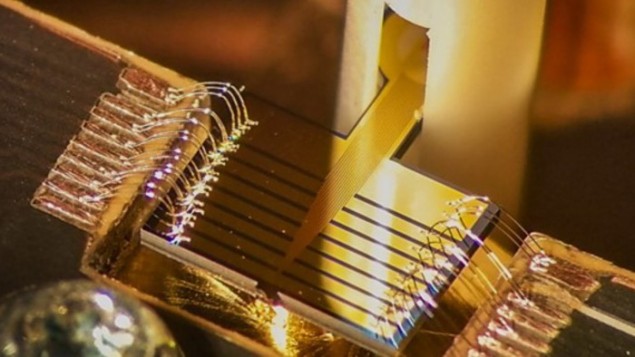
A single-photon detector that could boost the performance of some quantum key distribution (QKD) cryptography systems has been unveiled by Hugo Zbinden and colleagues at the University of Geneva and ID Quantique in Switzerland. The device contains 14 intertwined superconducting nanowires, which share the task of photon detection.
Quantum computers of the future could crack conventional cryptography systems. However, quantum cryptography systems should remain secure from hackers – at least in principle. One such system is quantum key distribution (QKD), which uses the laws of quantum mechanics to ensure that two communicating parties can exchange cryptography keys securely.
QKD involves sending and receiving strings of photons in specific polarization states. If an eavesdropper intercepts this communication, it disrupts the quantum nature of the information thereby alerting the correspondents.
Limited clock rates
While commercial QKD systems are already is use in some specialized applications, more widespread use of the technology is limited by the “clock rate” at which photons can be created, transmitted and detected. “The clock rates of these systems have increased continuously over the past 30 years,” Zbinden says. “But in modern systems, the speed of the detectors and the post-processing become the limiting factor for high secret key rates in QKD.”
These key rates control the speed at which communicating parties can exchange a secure quantum key. Higher key rates enable users to exchange more information – both more securely, and at higher speeds.
Today’s QKD systems use superconducting nanowire single-photon detectors (SNSPDs), which operate a cryogenic temperatures. A small region of the nanowire heats up when it absorbs a photon, switching temporarily from a superconductor to a normal material. This causes an increase in the electrical resistance of the nanowire, which is detected. After the photon is absorbed, the nanowire must cool down before it can detect the next photon – and this recovery time puts a limit on how fast an SNSPD can operate.
Simple yet sophisticated
In its study, Zbinden’s team implemented a simple yet effective fix to this problem. “The novel design of SNSPDs consists of 14 nanowires, which are intertwined in such a way that they are all equally illuminated by the light exiting the optical fibre,” explains Fadri Grünenfelder, Zbinden’s colleague at the University of Geneva. “This increases the chance that there is a wire that still can detect while some others are recovering.”
Another feature of the detector is that each nanowire is shorter than nanowires usually used in SNSPDs – which means that the individual nanowires can cool down faster.
Existing SNSPDs can support key rates of just over 10 Mbps, but the Swiss team has done much better. “The high maximum count rate of the SNSPD, as well as the increased timing resolution, helped to achieve a secret key rate of 64 Mbps over 10 km of optical fibre,” Grünenfelder says. “We could beat the previous record by more than a factor of four.”
Privacy amplification
By detecting photons at this rate, a QKD system could make any necessary error corrections, and carry out privacy amplification (a process which transforms raw key photons into a final secure key, independent of any information which might have leaked to an eavesdropper) – both in real time.

Slimmed-down terminal transmits quantum keys from space
For now, the cryogenic temperatures required for SNSPDs mean the technology is not well suited to everyday applications in QKD. “Other optimizations implemented for pushing key rates to the limit can be implemented in more mainstream, commercial QKD,” Zbinden explains.
However, the researchers still envisage a wide range of possibilities for their ultra-fast, highly efficient SNSPDs: from secure communication between distant spacecraft, to new generations of advanced optical sensors – which could be particularly useful in medical imaging.
The research is described in Nature Photonics.



